What to Eat in Vietnam: Your Ultimate Guide to Vietnamese Food
Exploring a new cuisine is definitely the most surprising part of a trip. People often find new tastes that they never knew existed. Sometimes you can even discover a hidden gem that makes you remember for a lifetime. After all, nothing can make a person fall in love with a whole country faster than tasting a delicious dish. In the eyes of a traveler, the local cuisine is an insight into the culture and history, presented in an enjoyable way.
For Vietnam travelers, local food is always one of the best highlights on their trips. Delicious, healthy, and affordable – what can be the reason to refuse a Vietnamese dish? But for the limit of most people’s guts, it’s impossible to try out every dish out there – even locals can’t do that.
How to get the most of Vietnamese cuisine? What are the must-try in each destination? Which dish would likely suit your preference the most? Save your time searching around! Let us walk you through this detailed food guide and answer all your questions.
pic1
A Glance of Vietnamese Cuisine
The Wonder of Vietnamese Food is The Perfect Balance
What foreigners remember the most about Vietnamese dishes is the balanced taste of sweet, sour, savory, spicy and bitter. The culinary philosophy behind is Yin and Yang: each dish is a harmony of taste, color, nutrients, and satisfaction to all 5 human senses. In the mindset of Vietnamese chefs, food is a way to nurture your health and to bring you pleasure. The ingredients are all inexpensive, but creative preparation makes food always appealing.
Influenced mostly by Chinese, Thai, and a century of French cuisine, Vietnam’s culinary system has a wide range of styles and tastes, which easily satisfies foodaholics from East to West. But local chefs creatively added their signature flavors with Vietnamese special ingredients and cooking methods. Banh mi may come from the French baguette, phở may look like pad thai, but the taste is so Vietnamese that you can tell the difference right at the first bite.
Food in Different Regions Doesn’t Taste The Same!
The diverse culture affects people’s taste buds greatly. In the North, locals prefer a light taste, so food is not specifically bold in any flavor, but rather a subtle, tender combination of different spices. This region gave birth to many signature dishes, such as phở, bún riêu and bánh cuốn, which later became iconic to the national cuisine.
The Central is famous for spicy food, thanks to the variety of spices produced here. Seafood like baby clams, shells and various fish from the long coastline make up a large part in the Central cuisine.
The Southern year-round warm climate offers people endless choices for fresh fruits and vegetables. A Southern meal is a colorful picture with a strong taste and smells. People in the South favor a sweet taste, so sugar or coconut milk is the frequent choice for marination.
pic2
Key Ingredients of Vietnamese Food
The most common ingredient in Vietnamese dishes is rice. Like other Asian countries, rice provides the main source of carb in locals’ daily meals. Hence, you’ll encounter various dishes that come with steamed rice, rice noodles or rice cakes. The elegant, balmy taste of rice complements savory dishes, helping you to feel their flavor clearer while reducing the oiliness.
Another staple in Vietnamese cuisine is the smelly nước mắm. This sauce comes from the salty juice of fermented fish. Nước mắm is a better spice than regular salt because it doesn’t only add saltiness, but also the umami flavor from fish meat to make the taste bolder. Mixing nước mắm with sugar, vinegar, lime juice, garlic, and chilies in a proper ratio, then you’ll have the best dipping sauce for any Vietnamese dish.
For protein, pork is undoubtedly the most common source, followed by chicken and beef. Not only because it’s affordable, but also the versatility makes pork a good candidate for different cooking methods. Maybe because the supply of livestock was limited in history, Vietnamese chefs never waste any part of an animal, from the organs like the heart, liver, intestine, to even throw-away body parts like chicken legs and pig tongues. With creative cooking methods, those seem- to – be – waste ingredients can become delicious, mouth-watering food!
Vegetables balance meat in the Yin and Yang culinary philosophy, both in terms of taste and health. There’s no dish that comes without veggies. Bean sprouts and mushrooms are the typical parts in meat fillings for fried and cakes. Carrots, green papaya or kohlrabi are frequently served as crunchy pickles. Lettuce, mints, and coriander are notable condiments to savory dishes, while spring onions can’t be missed from soup-based food.
That said, a Vietnamese meal is both flavourful and nutritious. Now, let’s dive into some signature dishes around Vietnam!
Vietnamese Nationwide Dishes: Most Popular Dishes in Vietnam
People may have different preferences, but there are some delicious dishes that won the nation’s heart. Here you’ll find the most beloved dishes of Vietnamese people. You will definitely encounter them at almost every food stalls and restaurants because locals devour them daily.
Thanks to their popularity, there are several good choices to taste them at any destination. In the scope of this article we just can’t recommend enough. Check out our detailed food list: Fantastic Vietnamese Dishes and Where to Find Them? where we recommend the best food addresses throughout Vietnam.
For now, prepare to feel hungry after learning about these wonderful dishes.
Phở (Vietnamese Rice Noodles in Beef / Chicken Soup)
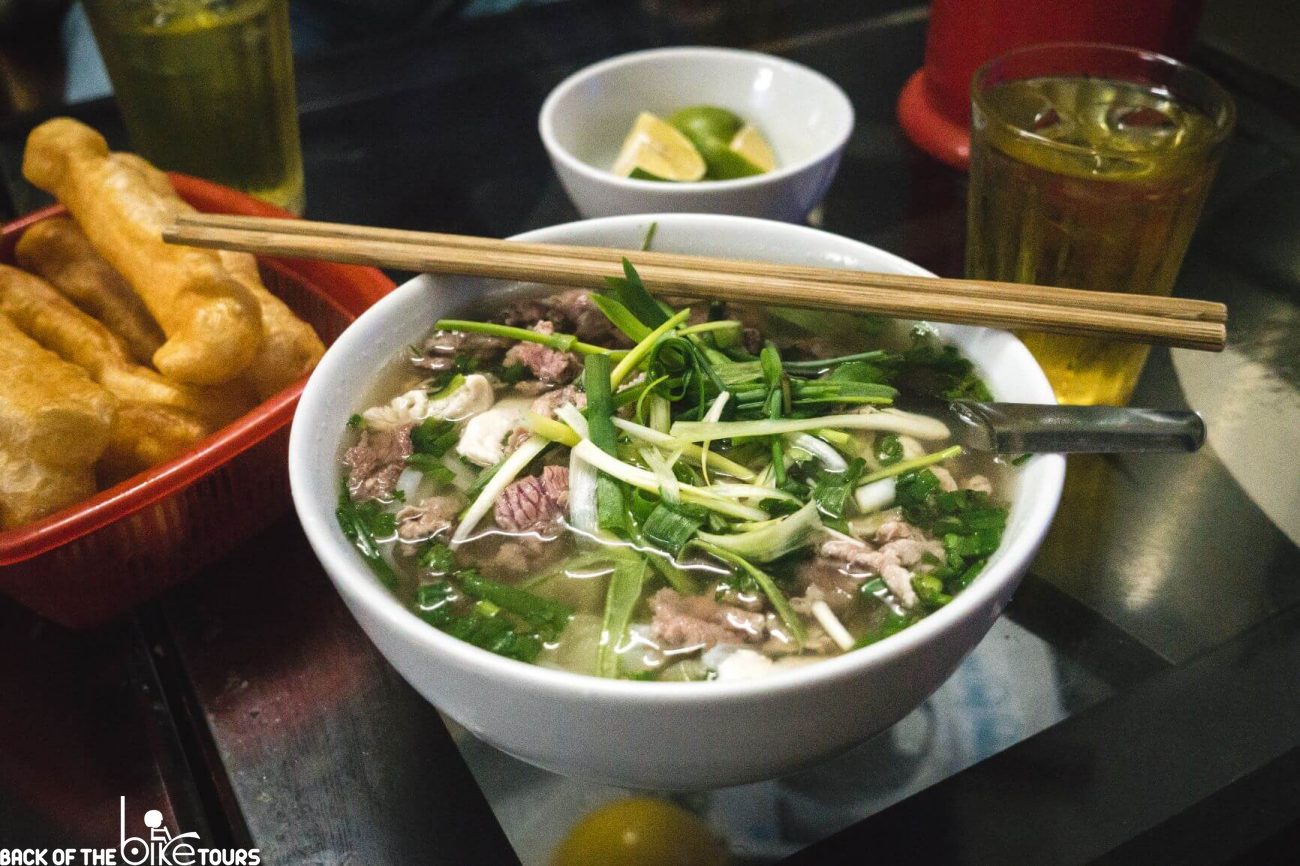
The hearty, aromatic soups of phở have millions of loyal fans worldwide. Some tourists come to Vietnam to eat phở at almost every meal, but find themselves still crave for it. That may explain why phở is the most iconic star that brings Vietnamese cuisine to go internationally.
A bowl of phở is composed of rice noodles, topped with thin-sliced meat and spring onions, then a splash of the boiling broth. Rice noodles for phở are thin and flat in medium – width. In the Vietnamese language, the rice noodle itself is also called phở, to distinguish from the round type called bún. The rice noodles are soft and fresh, prepared by quickly dipping it into boiling water right before serving.
Meat is the variable of phở’s taste. The most popular option is the beef. In beef phở, there are more ways to modify the taste: tái chín (half-done beef) remains the sweet and soft taste of the flesh, tái lăn (sauteed beef) adds more spices’ flavor to the meat while nạm gầu (brisket and flank cuts of beef) are crunchy.
Chicken is a modification from beef, and it’s always boiled chicken breast or thigh, thinly sliced then topped over the noodles. In many phở stalls, customers can make their phở bowl even heartier by adding mọc (pork meatballs) and trứng chần (poached eggs).
Veggies increase the aroma and freshness after having plentiful of carb and protein in the bowl. In the North, chopped spring onions and coriander are added by default. In the South, people have a separate dish with bean sprouts and other veggies, so they can add what they like. Maybe because the overall taste of Southern phở is fattier and sweeter, so it needs more veggies to balance out.
The last thing added to your phở bowl is the most important: the broth. The clear soup is the result after hours of simmering beef bones, oxtails, and flank steak. What makes it stand out is the distinct aroma that can only be described as “phở flavor”: the smell of cinnamon, star anise, ginger, and onions, enhanced by being roasted on the charcoal fire. All of them subtly blend into the broth. Nước mắm is the Vietnamese trademark into phở broth.
Even though the taste is already great, you can enhance it to suit your taste buds by adding condiments like garlic vinegar, fresh minced chilies, some squeezes of lime juice, or more nước mắm. No phở stall can lack these condiments on their tables. A typical side dish you can ask for is quẩy (fried dough sticks). These crunchy dough sticks taste great as well when dipped into the phở broth.
Bún Riêu (Rice Vermicelli in Crab And Tomato Soup)
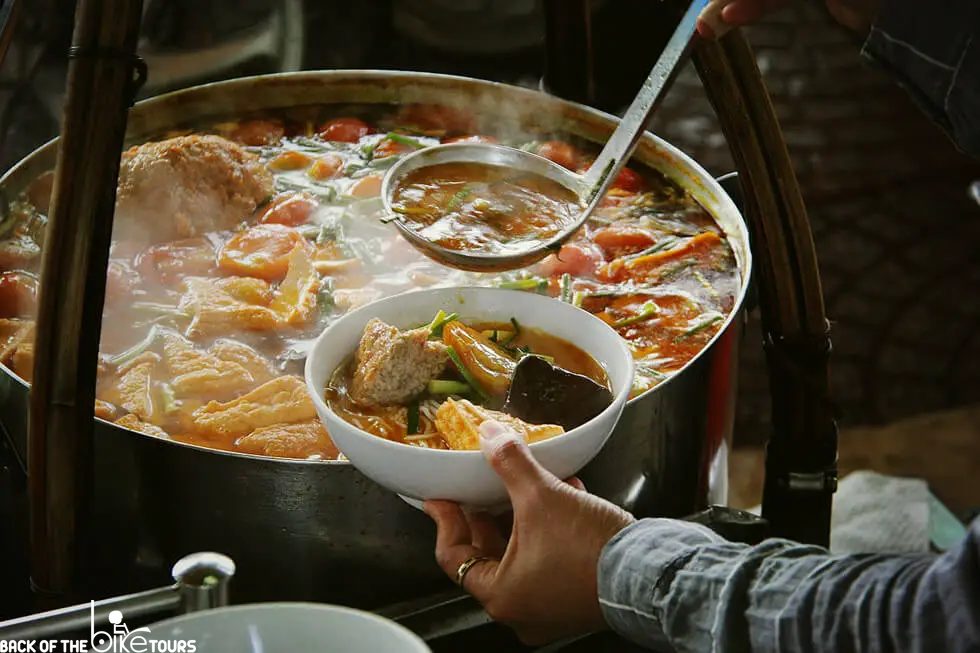
This soup-based dish is lesser-known that phở, but it’s always a pleasant surprise for tourists to find out. The carb base is rice vermicelli or bún. It differs from phở noodles only in the shape of round, thick sticks. This soup was once the signature dish of Northern Vietnam because the main ingredients are freshwater paddy crabs from rice fields in the Northern Delta. Even though the cooking process is meticulous, the dish quickly gained people’s favorite and arrived in every corner in the country.
Crabs are the soul of this dish. These tiny crabs are carefully cleaned and smashed – flesh and bones – into a fine paste, then strained several times to gain the “crab liquid”. Combined with tomato and rice vinegar, the “crab liquid” defines the taste of bún riêu: umami, sweet and subtly sour. The crab meat is separated from the shells, sauteed with shallots and is called “crab cakes”, then topped over the noodles along with fried tofu.
The red hue of the broth is balanced by the green color of water spinach, crunchy shredded banana flower, nutty bean sprouts, and other aromatic mints. If you need more proteins, ask for sauteed beef or pork meatballs into your bowl.
If phở warms up your soul on a winter day, bún riêu is definitely a dish of summer. According to the Yin – Yang philosophy, crab and seafood, in general, are “cold” food, which helps our body release heat. The vibrant color of the tomato soup also goes well with the cheerful vibe of summer.
That doesn’t mean bún riêu is summer – only. The dish is a popular daily breakfast choice as it’s nutritious enough to fuel your day, but doesn’t make you feel stuffed.
Xôi (Sticky Rice with Various Toppings)
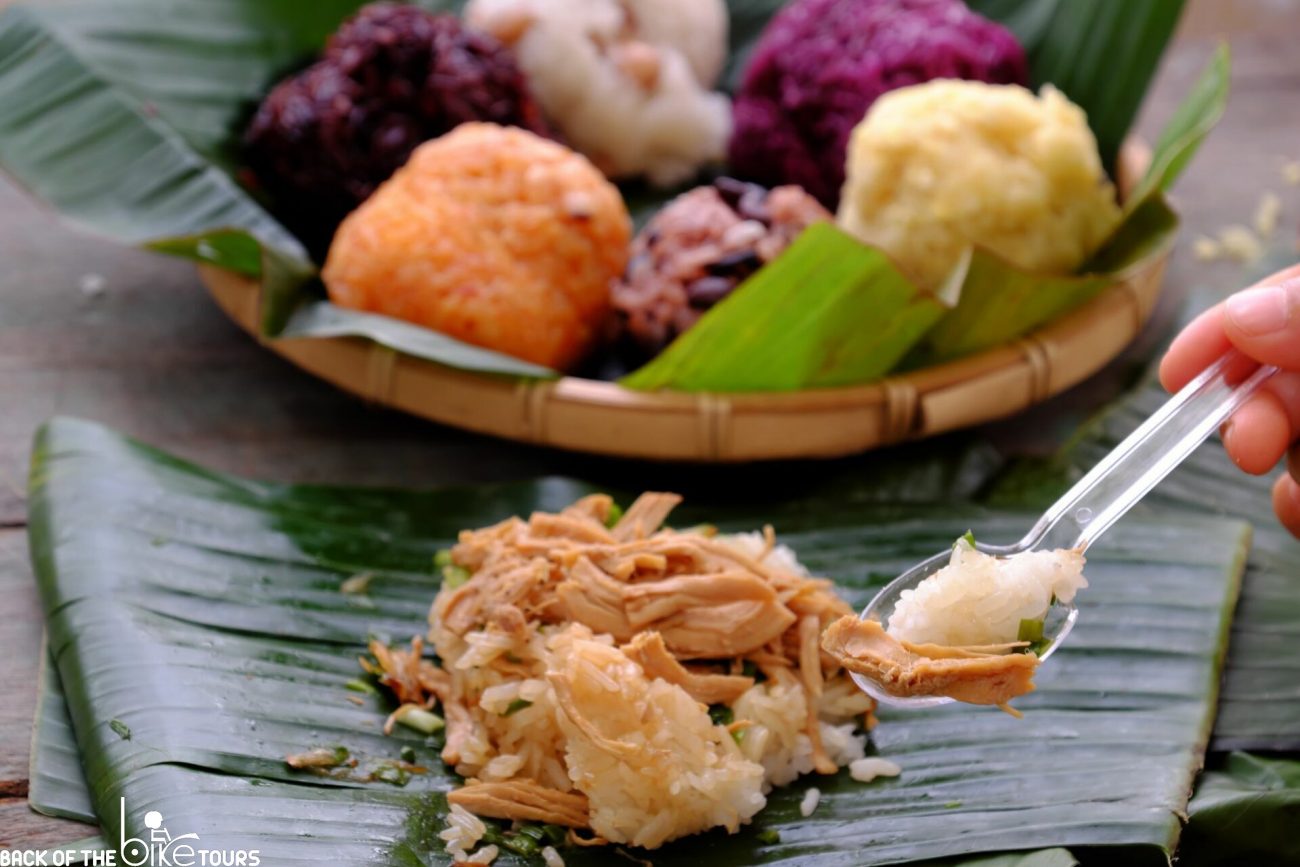
Sticky rice, compared to the regular rice that is eaten daily, is more versatile. That means they can be cooked for savory dishes and desserts. It used to be cooked for special, festive occasions only.
Due to the glutinous property, sticky rice is often steamed than boiled to keep it from being too wet. The most common savory xôi is xôi xéo. The rice is mixed with turmeric powder, then steamed. Melted chicken fat is splashed onto the cooked rice, giving it a yellow, glowy color. Mung beans are cooked and smashed, then shaped into firm balls. Those mung bean balls are sliced thinly to top the rice.
The star of the dish is a handful of deep-fried shallots and meat floss sprinkled all over the bowl. If you have a big appetite, add fried eggs, pork sausages, soy sauce stewed pork. Don’t forget to balance the oiliness with pickled cucumber.
Xôi xéo is probably one of the best takeaway meals thanks to its convenience. It contains everything you need to fill your hungry stomach in the early morning or late at night. You can easily spot many street food sellers with baskets full of smoking hot sticky rice. A small box of xôi xéo costs even less than a cup of coffee, but it can fuel your whole day activities. That’s why it’s the favorite breakfast choice of students and workers.
Bánh Mì (Vietnamese Baguette)
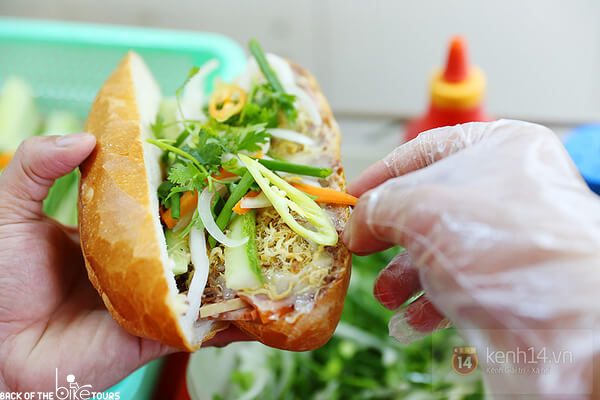
Like phở, bánh mì brings Vietnamese cuisine to go global. This sandwich was introduced to Vietnamese by the French. That may explain why it easily gets favored by Western eaters. The word bánh mì refers to both the plain baguette only or the sandwich. When people talk about bánh mì, they often mean the latter.
Bánh mì is probably the easiest dish to make in the Vietnamese food universe. Get a plain baguette, split it lengthwise, then fill in savory ingredients that you like and tada, you have a bánh mì ready to be served. The common fillings are pork sausage, fried eggs, pate, supplemented with coriander, mint, pickled cucumber and carrots, then add as much mayonnaise, chili and ketchup as you like. Sounds almost like your mother sandwiches!
But don’t judge a book by its cover! Once you take a bite, your taste buds are likely to be blown away by the amazing fusion of all ingredients. Start from the outside, you’ll feel the crusty outer of the baguette meltdown on your tongue. Then comes a tornado from savory meats in sauces, fresh veggies, sour and crunchy pickled, creamy pate and fluffy bread. After you swallow, the aftertaste causes you to crave another bite.
From the original settings, bánh mì now has various forms throughout Vietnam. The modifications focus on fillings, especially the meat and the pate, by enhancing their flavors or introducing new ingredients. Popular fillings are grilled lemongrass chicken and barbecue pork.
Like xôi, bánh mì is a convenient takeaway food that can satisfy your stomach for breakfast or a quick mid-day snack. Bánh mì sellers appear everywhere, from mobile carts to in-house food stalls. Often they are recognized with piles upon piles of baguette and all ingredients displayed in the front, which definitely speaks more than any sign.
Bánh Cuốn (Steamed Rice Rolls with Minced Pork and Mushrooms Fillings)

If you looking for a light snack that tastes fresh, then bánh cuốn is the right dish to try. Watching the cooking process is the most interesting part. Bánh cuốn is always cooked right in front of customers at the order. The chef starts by pouring the liquid rice flour onto a big steaming pan and spread it evenly. The thin layer of liquid solidifies quickly to the heat of the steaming pan. At the right moment that only experienced chefs can sense, they lift up the fragile, slippery rice crepe from the pan. The timing is important: Undercooked rice crepe will tear down when lifted up, while overcooked once is no longer soft and gummy.
Now the smoking hot crepe is spread on the table, quickly topped with seasoned minced pork and mushrooms. A few rolls to shape it, with a generous sprinkle of deep-fried shallots to finish. Now your yummy hot bánh cuốn is ready to serve.
The taste of bánh cuốn is mild and subtle, so you need nước mắm as the dipping sauce. Pork sausage and meat floss can be added as a side dish to make the meal heartier. In some famous bánh cuốn restaurants, eggs can be the substitute for pork fillings, making the dish almost like a light omelet. Shrimp floss is also an enhancement to normal pork meat floss that produces a unique taste.
Due to the meticulous preparation process, bánh cuốn is not for those who are in a hurry. It is often a great breakfast on a lazy weekend morning.
Bánh Xèo (Crispy Crepe with Pork, Shrimp, and Bean Sprout fillings)

Somewhat similar to bánh cuốn, bánh xèo (“sizzling cake”) is made from rice flour. Instead of the white, gummy look, rice batter to make bánh xèo is mixed with turmeric powder to give it a shiny, yellow hue. Cooks pour scoops of turmeric rice batter onto the hot skillet, making the distinct sizzling sound of boiling oil, which gives the dish its name.
Once the rice pancake starts to turn golden, the fillings are topped, then cooks fold the pancake into half. Fillings compose of mini shrimps, minced pork belly with a lot of bean sprouts and chopped spring onions. The final result is this omelet – like, half-moon shaped, crispy pancake with moist fillings.
The pancakes are served with a small plate full of lettuce and different mints. Cut it into bite-size pieces, put 1 piece on the rice paper with veggies and roll it – that’s how locals do. Dip your rolls into the dipping sauce, which is made of peanut sauce or nước mắm, then take a generous bite. The crunchy outer layers, the savory fillings, and the fresh aromatic herbs all blend together then melt on your tongue, leaving you a gastronomical delight.
Vietnamese Spring Rolls: Fried or Fresh Rice Paper Rolls With Savory Fillings

There are 2 equally popular types of Vietnamese rolls that people often mistake: a fried one and a fresh one. Though they differ in a lot of aspects, both are made of rice paper, wrapping around the fillings of pork, rice vermicelli, and veggies, then served with dipping sauce. The sauce can be peanut sauce or nướcc mắm mixed with sugar, vinegar, and garlic.
The fried type is called nem rán (Northern dialect) or chả giò (Southern dialect). Its fillings combine ground pork with mushrooms, shredded carrots, kohlrabi, and soaked rice glass vermicelli. Eggs bring moist and cohesiveness to the mixture. Spoon the fillings on to a damped rice paper, fold the sides and roll – your rolls are now in the right shape. Deep frying them in a lot of oil to make the rice paper crispy, then serve them hot with fresh herbs and dipping sauce, along with steamed rice or bun.
Always taste your nem rán hot because it will lose the crispiness when cooled down. The dish is a perfect appetizer as it wakes all your taste buds up at one bite. Nem rán is an irreplaceable dish in the family meals of locals during festive seasons.
The second type of Vietnamese rolls is called gỏi cuốn. It requires less time to prepare but tastes great as well. In contrast to the oily taste of nem rán, gỏi cuốn is fresh and delight as fresh vegetables take up the most part in the ingredient list. The rice paper used for gỏi cuốn is the same as nem rán, though it doesn’t get fried, remaining the soft and a little bit gummy taste. The fillings are pork belly and shrimps, bún, cucumber, salads, and herbs.
You only need to assemble the cooked ingredients onto your rice paper sheet, fold and roll, and all the work is done! Dip the rolls generously into nước mắm, and take a bite: “refreshing” is the best word to describe the taste. This dish is a wonderful summer appetizer since it’s served cold, with a light, elegant flavor that doesn’t make you sweat while devouring.
Drinks: Cafe, Beer, and Tea
As a tropical country with hot year-around weather, drinks are the frequent after-meal “dessert” for locals. Breakfast on a relaxing Sunday morning is not complete without a cup of coffee. Many phở and bún stalls serve tea instead of plain water. And if you are ever invited to hang out with locals, you’ll likely end up in a bia hơi (beer) restaurant.
Coffee was another good thing that the French brought to Vietnam, besides bánh mì. From a country that only favored tea, now coffee is loved nationally and even more symbolic to Vietnamese cuisine than tea. The Central Highlands of Vietnam is dedicated to producing coffee, mostly Robusta.
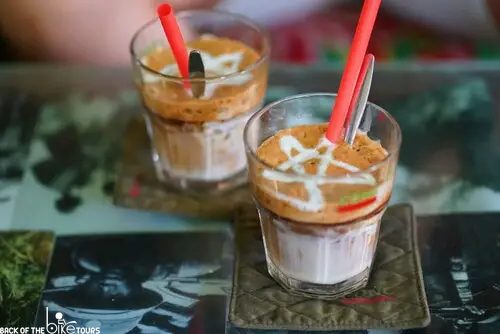
What makes Vietnamese coffee stand out is in the preparation: the dark roasted ground coffee is slowly dripped through a special device called phin, which makes the flavor more intense than an American drip. So if you love strongly brewed coffee, cà phê đen (“black coffee”) is your must-try.
For people with a sweet tooth, try cà phê nâu (“brown coffee”). Condensed milk is added here to reduce the bitterness and to bring out a creamy taste. Cà phê sữa đá is created when adding ice. This is a refreshing beverage that wakes up your mind and cools down your heat. Hence, it’s the most popular drink for people in the South.
If you would like a hot cup of coffee to warm up in winter days, try this special version of coffee in Hanoi called egg coffee. Egg yolk in milk is whipped to a creamy, foamy texture, then layered on top of black coffee. It tastes like a less-sweet tiramisu, or eggnog but with a strong coffee flavor.
Tea is a more elegant way to wake your body up than coffee. Nowadays, tea may not be as popular as coffee, but it still appears in the everyday life of people. For festive occasions like weddings and family parties, tea is irreplaceable. Vietnamese green tea has medium caffeine content and a mildly bitter taste. If you are a tea lover, don’t miss special flower-infused tea of Vietnam, such as lotus and jasmine tea.
Finally, bia hơi (Vietnamese draught beer) is the most common way to socialize with Viet people. After working hours, you’ll see groups of men flocking in and out beer restaurants, cheering with their large glasses and chatting enthusiastically. Bia hơi is brewed daily and matured for a short period, so it allows even light drinkers to finish a full glass.
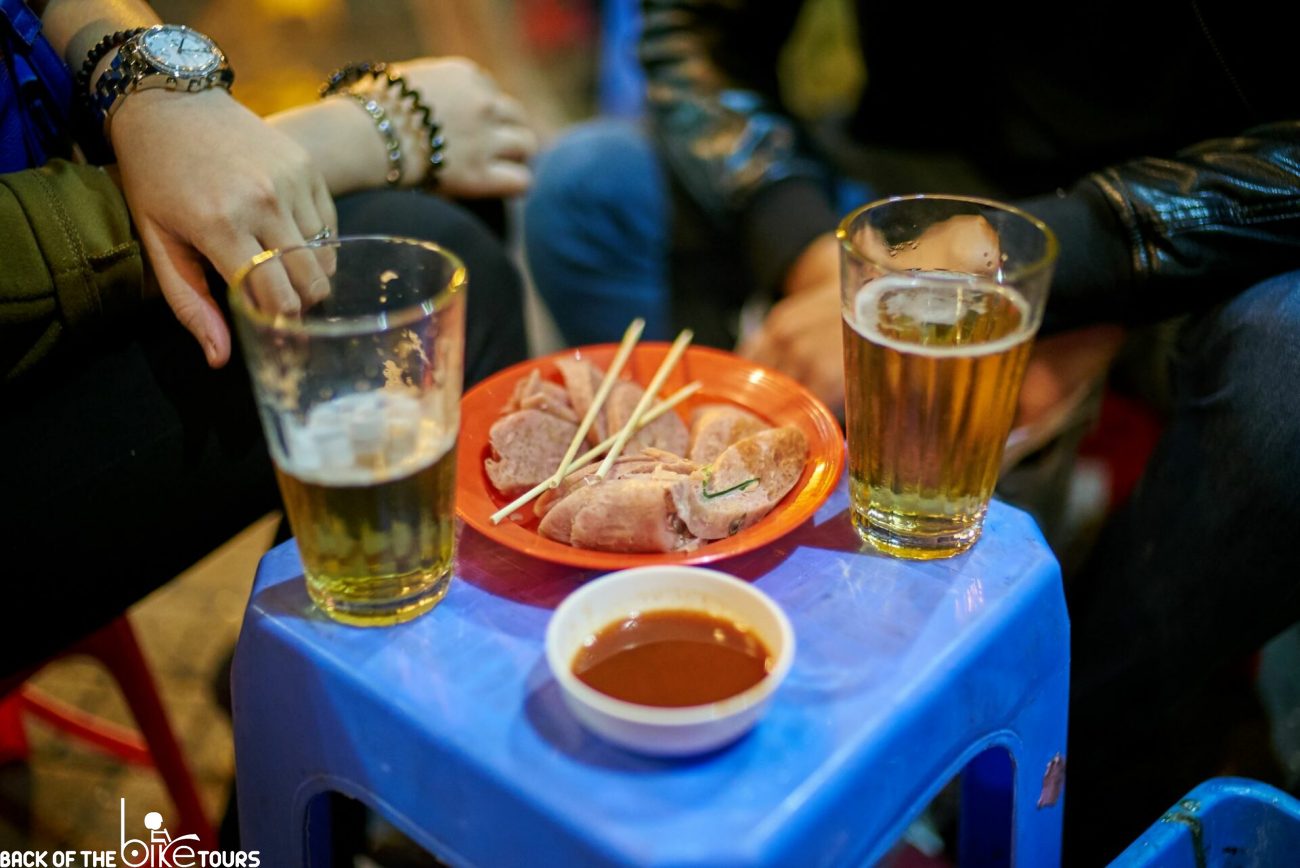
Drinking beer with ice may be weird to you, but it’s a common thing in Vietnam. Since the beer is already light, adding ice won’t change its taste drastically. Instead, iced bia hoi has an amazing cooling effect. Locals often drink bia hơi with grilled seafood such as snails and shellfish. This even becomes an official culture of Vietnam, called ăn nhậu.
Vietnamese Regional Specialities: Unique Dishes from North to South
The varied climate and multi-culture give each region of Vietnam a few signature dishes. There is some food that only tastes good when you try it at its birthplace, as nowhere else can replicate the same flavor. When you visit a city, try not to miss any of them!
Iconic food in Sapa
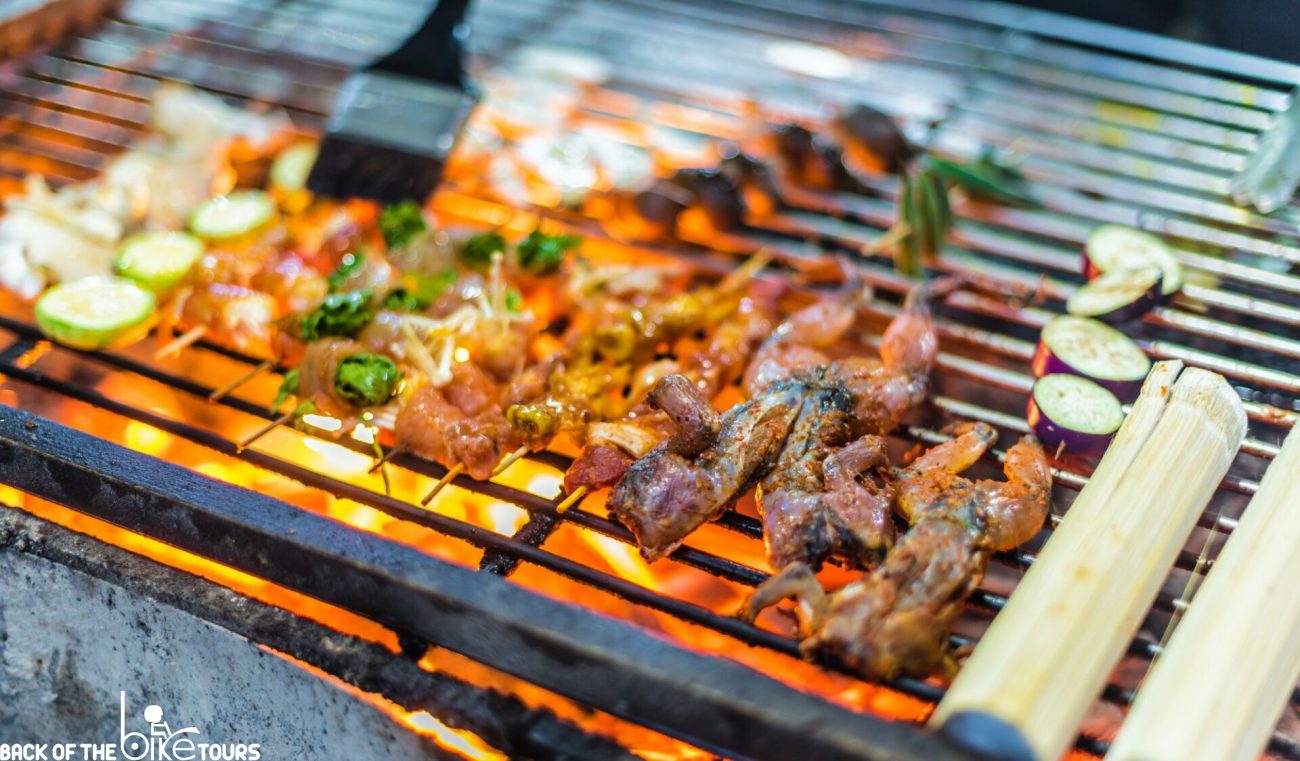
Gà nướng mật ong (Grilled Chicken with Honey)
The secret for this dish’s amazing taste lies in the chicken: black-bone silky fowl or gà ác in Vietnamese. They are raised by Mong people, and what sets it different from normal chickens is not only the dark color of meat but also the valuable health benefits. Coated in forest honey then grilled on charcoal, this dish simply tastes excellent. The light spicy of mints and lime leaves really brings out more fragrant and keeps your mouth watering unstoppably.
Lợn Quay (Whole – pig Barbecue)
Like the above dish, this pork barbecue is special because of the pig breed called lợn cắp nách. The name means “armpit pig”, which refers to the fact that local sellers usually hold their pigs under the armpit while selling them on the market. Armpit pigs are a local breed that doesn’t weigh more than 20kg. Local farmers let them grow wild in the forest, hence they are more active, resulting in a firm and textured flesh.
The whole-pig is marinated with distinct spices, then roasted over a charcoal fire. The meat is soft and juicy while the skin is crispy and savory. This dish goes perfectly with a bowl of steamy sticky rice.
Lẩu Cá Hồi (Sapa Salmon Hot Pot)
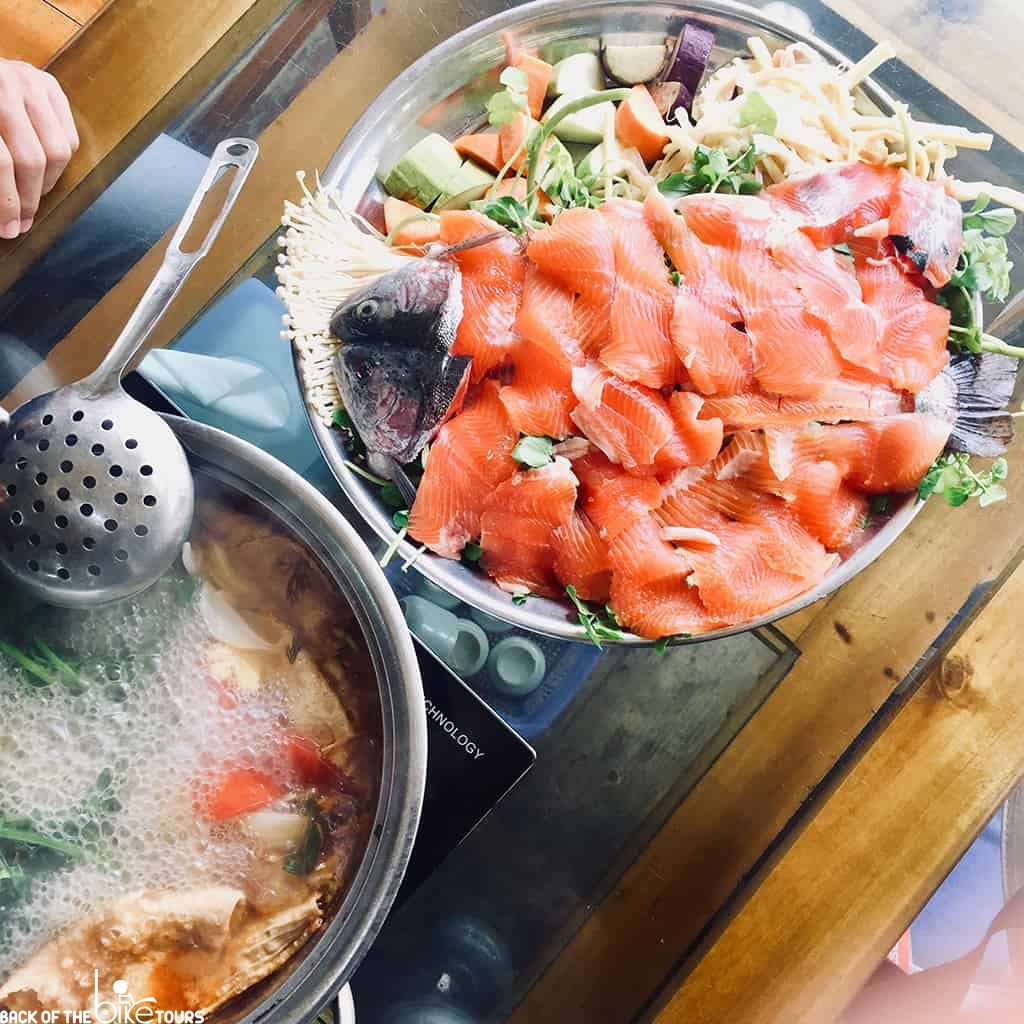
Natural salmon prospers in the streams and waterfalls of Sapa, giving them a less greasy and firmer taste compared to imported salmon. With the generous supply of nature, salmon is a specialty of Sapa than you should not miss once you are here. The best way to enjoy Sapa salmon is by eating salmon hot pot because it suits the cool weather of this mountainous city.
Don’t forget to have a few glasses of corn wine from the Muong tribe while tasting these dishes. After that, you can proudly say that you have tasted the best of Sapa.
Best Eat in Hanoi
Bún Chả (Rice Noodles with Grilled Pork)
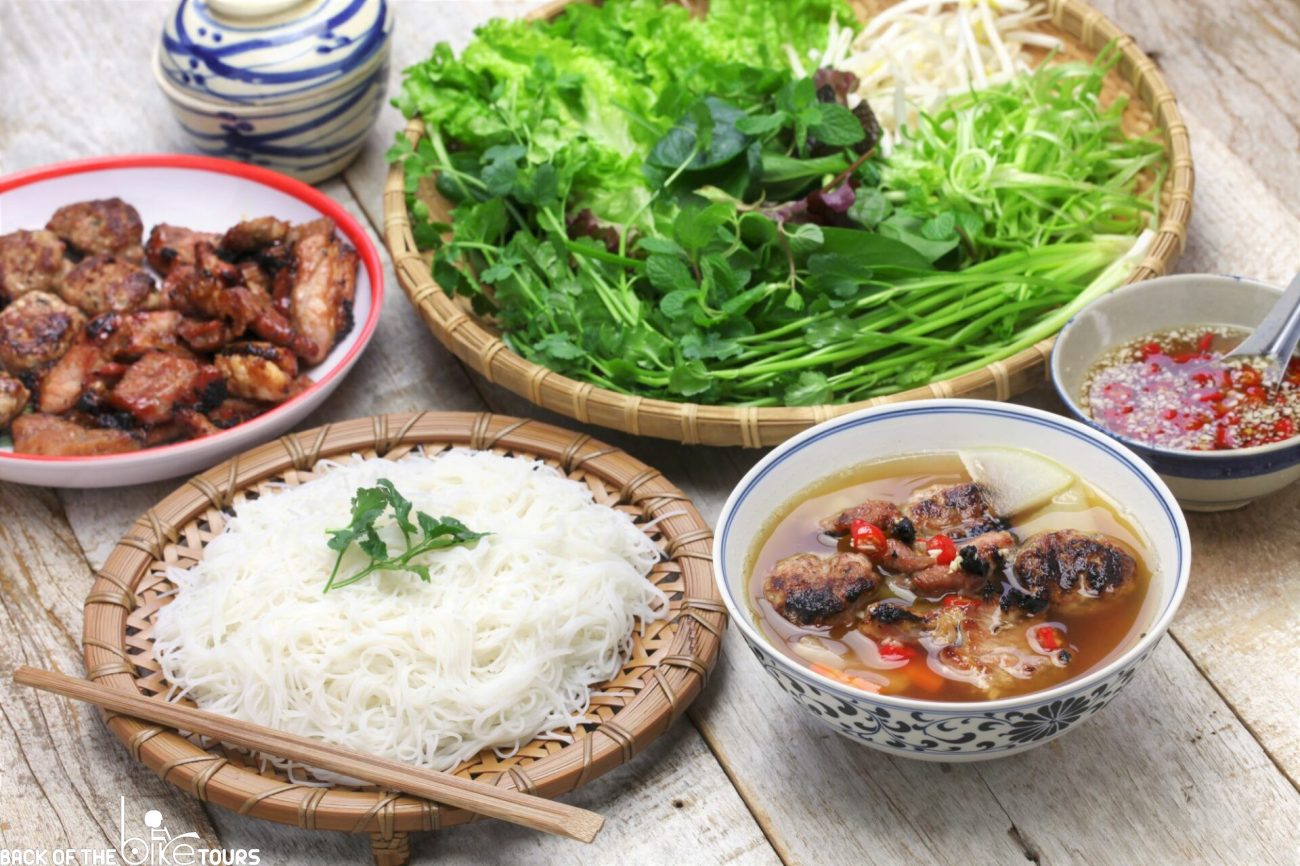
Before Barack Obama and Anthony Bourdain brings international fame to bún chả, this dish has been the beloved and the pride of Hanoi people for centuries. As suggested from the name, this dish includes a plate of cold rice vermicelli (bún) with a bowl of charcoal-grilled pork (chả) in a light soup. The soup is made from diluted nước mắm, mixed with sugar and pickled crunchy carrots and green papaya.
When serving, a plate of various herbs can’t be missing. Adding minced garlic and some squeezed of lime juices to your soup bowl is recommended to refine the taste. To eat bún chả, dip rice vermicelli and herbs into the soup, and take a mouthful of all parts to get the whole wonderful taste.
The pork meat is a mixture of pork belly slices and pork shoulder meatballs. The marination sauce of salt, pepper, sugar, nuoc mam and shallots brings out a distinct fragrant one the meat is grilled. The smell of bún chả is as appetizing as the dish itself. When you wander around the Old Town district of Hanoi at lunchtime, you can smell the delicious bún chả in most streets.
Chả Cá Lã Vọng (Grilled Fish in Turmeric Paste)

This dish was created over a century ago and Hanoi people love it so much that they named a whole street after it. The main ingredient is a special large-sized catfish from Northern rivers. The freshness in the meat is a big factor contributes to the final succulent taste.
Fish meat is cut into bite-sized, rectangular pieces, then marinated with turmeric and galangal juice, fermented rice paste, and shrimp paste, before grilling on charcoal. The recipe and marination method are kept as a precious family secret, giving this dish a distinct flavor in each restaurant.
The dish’s serving is as meticulous as the preparation. Grilled fish is fried in fat, not oil, to keep them hot, to bring out the fragrant and to give the meat a shiny caramel color. Add some fresh dills and spring onions to the boiling pan and quickly stir it, then your fish is ready to eat. Like bún chả, cold rice vermicelli is the best staple food to pair with chả c as it reduces the oiliness and balances the heat.
Fish paste is the best dipping sauce for chả cá. The smell is even stronger than nước mắm, which sometimes makes foreigners hesitate to try this amazing dish. Add lime juices and whip your fish paste foamy – now not only the smell goes away, but the taste is much better!
Bún Thang (Rice Noodles Soup with Various Toppings)
There’s a fun explanation to the origin of bún thang: the dish was created by combining all the left-over food after festive meals in New Year Eve. It may be true, considering the variety of ingredients in the dish: chicken, egg, sausage, pork, shrimp and of course, mushroom, chives, mint, and coriander to garnish. The most distinct feature of bún thang lies in its special condiment: a few tiny drops of beetle juice!
However, the dish is not a simple mixture of meat and veggies. The presentation truly reflects the elegance of Hanoi residents. All ingredients are cooked separately, then thinly sliced and topped over the noodle in the sweet bone broth. A bowl of bún thang is always so hearty and aromatic that it warms up both your gut and your soul!
Must-try Food in Hue
Cơm Hến (Steamed Rice with Baby Clams)
The romantic Perfume River is a lavish source for freshwater seafood like clams, shrimp and fish. Among all seafood dishes in Hue, cơm hến is the most notable because it represents the “Hue flavor” the most and contains all the distinct ingredients of this area. If you leave Hue without trying cơm hến at least for once, then your trip is incomplete!
To make cơm hến, fresh baby clams are soaked in rice water for hours to remove dirt and cooked by boiling. The clam meat is mixed with cooked rice, sliced sour star-fruit, coriander, chopped Indian taro leaves, and banana flower. The veggies for cơm hên can get varied, but they all come from distinct species in Hue that are not often seen in other regions’ cuisine.
The dish is pretty spicy thanks to the generous amount of pepper and chilies. Like other Vietnamese dishes, nước mắm replaces salt to give the mixture a salty touch. Finally, peanut, crunchy deep-fried shallots, and chopped crispy pork skin are sprinkled all over the top.
All ingredients for the mixture are cool, but before you eat, you need to add a splash of hot clam boiled water to complete the taste. Locals love to add even more chilies to get the most authentic taste, but even without it, the dish is great already.
Bún Bò Huế (Rice Vermicelli in Beef Soup, Hue Style)
There are different regional versions of this dish, but whenever locals mention beef soup with rice vermicelli, the first place we think of is Hue. Both the origin and the ingredients of the dish are tightly connected to Hue.
Even though the name only mentions beef, pork is also the main ingredient for bun bo. The broth is made by simmering pork feet, oxtail, pork bones, and beef flank cut for a long time. The distinct red hue and aromatic smell of bun bo come from chilies powder, cashew powder, and lemongrass. A special, less smelly type of shrimp paste that is mostly produced in Central Vietnam gives bun bo a trademark of Hue cuisine.
Like other noodles, the tender pork feet and beef flank cut are sliced and topped over rice vermicelli. Beside normal chopped spring onions, crunchy shredded banana flower, morning glory, and mints are sprinkled over meat. A scoop of delicious broth finishes the preparation, and your appetizing bun bo bowl is now ready to get devoured.
Nem Lụi (Grilled Pork-Wrapped Lemongrass Sticks)
The name explains it all: this delectable dish is made of ground pork that wrapped around lemongrass sticks and grilled on a charcoal fire. Besides the delicious smell of lemongrass, a special spice called thính is used to marinate the meat. To make thính, rice is roasted until golden, then ground into a fine powder. The aroma is so attractive that it’s also used to bait fish.
The dipping sauce is also what makes nem lụi’s taste so unique. The preparation for the sauce is even more meticulous than the meat itself. The sauce is made of finely smashed peanut into a fine paste, adding a little bit of nước mắm, and ground pork liver. This creamy mixture is then sauteed until it gets thickened and fragrant. Lime juices and minced chilies bring out the final heavenly smell.
The authentic way to taste nem lụi is to remove the stick and put the meat on a rice paper, along with herbs, slices of green papaya, star-fruit, green banana, and cucumber. Roll and dip all into the sauce, then take a bit to get the feeling of juicy, savory meat, sour veggies and fresh herb fused together in your mouth. This dish is a perfect choice for a mid-day snack after touring around the romantic Hue city.
Unique Food in Hoi An – Da Nang
Cơm gà Hội An (Hoian Chicken Rice)
Devouring this dish has become a habit of Hoian people. If you search for a place to eat cơm gà, you’ll likely get lost in several places, from small food stalls to fine dining restaurants. Even though the preparation is relatively simple, you’ll never get the same taste in different places since each has their own secret recipe.
Generally, a dish of cơm gà comes with steamed rice, shredded boiled chicken, pickled and a small bowl of chicken broth. The chicken is the star of the dish, which is soft, fatty and juicy. Chickens are raised at small farms, so they taste much better than regular industrial chicken. The skin is tender with a golden shiny glow from turmeric powder. Rice is cooked by using chicken broth, so not only the texture is fluffy but the flavor is bolder and fragrant. The accompanying veggies are also simple: some sliced of onions, coriander, and shredded carrots with green papaya.
Mix all parts together, and slowly add spoons of the chicken broth while you are eating to keep the rice not too wet. You can ask for the crunchy chicken intestine and eggs in your chicken broth to make the dish more bellyful. Optionally, add a spoonful of home-made chilies sauce to jazz up the taste.
Cao Lầu (Special Hoi An Noodles with Roasted Pork)
Cao lầu is probably the most famous dish in Hoian cuisine. Even though it tastes amazing, the dish is limited in Hoian due to a special ingredient: water. It’s said that only the water from a local well, mixed with ashes from native trees, can produce the authentic rice noodles for cao lầu. The noodles must have a chewy texture, smokey fragrant, and the yellow hue of chicken skin.
Unlike most other noodles, cao lầu doesn’t require broth. Nước mắm, soy sauce, with some sprinkles of sugar and pepper is enough to enhance but not blur the noodles. Then crispy roasted pork, crunchy rice crackers, bean sprouts, and herbs complete the taste. Mix them all together and you get a yummy, savory with a hint of spicy taste. Devour as much of it as you can, because you won’t find it again anywhere else.
Mì Quảng (Rice Noodles in Chicken Broth and Plentiful Proteins)
Mì Quảng has the same position in Danang people’s hears, just like cao lầu to Hoian residents. This hearty noodle is special thanks to its plentiful of proteins toppings: chicken, marinated grilled pork, shrimp, boiled quail eggs. In different restaurants, customers can even have eel, fish, frog, or jellyfish, which come fresh daily from the Danang sea. The rice noodle is thick and chewy like cao lầu noodle but it remains the soft, balmy flavor of white rice. The generous amount of crushed peanuts and roasted rice crackers makes the bite more crunchy.
The broth of mì Quảng is chicken broth. However, the chicken is marinated with many spices like turmeric powder, pepper, and nuoc mam before quickly sauteed, then simmered until the soup is condensed. The broth is, therefore, bolder than normal chicken broth. The noodle also absorbs much broth, making this dish not too soupy like Northern noodles.
Thanks to the proximity between 2 towns, you can find mì Quảng at several restaurants in Hoian. However, for the most variety of fresh seafood, it’s better to keep this dish on your list until you come to Danang.
Symbolic Dishes in Ho Chi Minh City
Hủ Tiếu Nam Vang (Chinese – Cambodian style noodles)
Hủ tiếu is a type of Southern Chinese noodles, while Nam Vang is the Vietnamese name for Phnom Penh – Cambodia’s capital. As you can see from the name, this dish is the best reflection of the multi-culture life in Southern Vietnam, with a fused influence between Chinese and Cambodian cuisine.
The chewy rice noodle is eaten in pork bone broth. Salt, sugar, soy sauce, roasted dried squid and dried shrimp are the main spices for the broth, while carrots and radish make the taste sweeter and less greasy. The toppings can vary, but ground pork sauteed in the broth is always a must. Then other proteins like shrimps, pork liver, pork intestine, crab, squid are topped over with a sprinkle of chopped celery and spring onions.
The soup has this hint of sweetness and bold fragrant that is distinct for every Southern dish. Meanwhile, the combination of various toppings makes it so hearty and flavorful. Because the dish has the influence of Chinese cuisine, soy sauce is a better condiment for it than nước mắm.
Cơm Tấm (Broken Rice with Grilled Pork Ribs)
Another excellent symbol of Southern cuisine is cơm tấm. This dish was thought to originate from the poor working class, who could only buy broken rice – a damaged, cheap rice product. It is the most favorite breakfast choice of Saigon residents. Like other dishes of Vietnam, being cheap doesn’t affect the taste at all. In contrast, the broken rice is nuttier than regular soft rice, so it does make a different culinary experience.
But the real star of the dish is the pork ribs. Marinated in sweet and sour sauce, then grilled over a charcoal fire, the smell only is enough to make you mouth-watering. Pork sausage, sunny-sided eggs, and crispy roasted pork skin are the complements. And of course, sour pickled carrots and cucumber join the dish to balance the oiliness. A spoon of sweet nước mắm, which is diluted nước mắm mixed with sugar and lime juices, gives the dish the sweet-savory taste that Southern eaters love. Nước mắm comes in a separate bowl so you can adjust the taste as you like.
Bún Thịt Nướng (The Southern Twin of Bún Chả)
Same main ingredients, similar cooking method, but bún thịt nướng and bún chả still differ. This pair is probably the best example of regional variation in Vietnamese cuisine. Each dish is tasty in their own way, hence it’s worth trying both.
Since Southern people crave sweetness, so spices, honey, chopped lemongrass, and minced garlic are added right from the marination of pork. The dipping sauce also has more sugar, but the sauce is less diluted, hence it’s thicker than bún chả’s sauce. Another difference is a little bit of oil that was used to fried shallots would be splashed onto the dish. It gives the meat a shiny glow with attractive fragrant.
The serving style is totally different. For this dish, everything is already assembled: the grilled pork, cold rice vermicelli, herbs, and sauce. All you need to do is mix them together. Roasted peanuts are also present in the mixture, like other Southern dishes. Grilled shrimps, pork sausage, or chả giò (Vietnamese fried spring rolls) are some frequent additives.
That’s already a lot to try on your culinary exploration here. Is there any dish that makes your mouth watered? If yes, note them down and try them as soon as you get to Vietnam. Wish you a successful food journey in Vietnam!
If you still feel lost in this gastronomical heaven, don’t hesitate to contact us. We provide various food tour options and our experienced tour guides are always happy to be your company!
